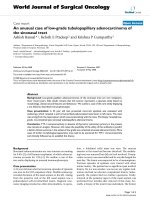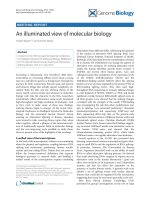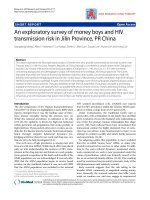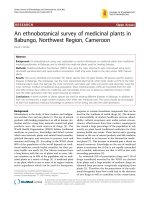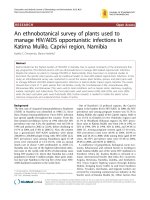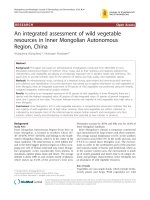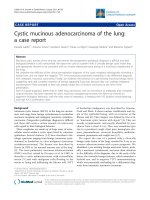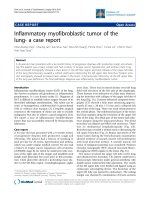Báo cáo y học: "An unusual case of autoimmune pancreatitis presenting as pancreatic mass and obstructive jaundice: a case report and review of the literature" pot
Bạn đang xem bản rút gọn của tài liệu. Xem và tải ngay bản đầy đủ của tài liệu tại đây (450.85 KB, 4 trang )
CAS E REP O R T Open Access
An unusual case of autoimmune pancreatitis
presenting as pancreatic mass and obstructive
jaundice: a case report and review of the
literature
Nephertiti Efeovbokhan
1
, Ashima Makol
1
, Reuben V Cuison
2
, Rebecca M Minter
3
, Veera-Pavan Kotaru
1
,
Barbara A Conley
4
and Sreenivasa R Chandana
5*
Abstract
Background: Autoimmune pancreatitis is a rare chronic inflammatory pancreatic disease that is increasingly being
diagnosed worldwide. As a result of overlap in clinical and radiological features, it is often misdiagnosed as
pancreatic cancer. We report the case of a patient with auto immune pancreatitis that was initially misdiagnosed as
pancreatic cancer.
Case presentation: A 31-year-old Caucasian man presented to our hospital with epigastric pain, jaundice and
weight lo ss. His CA 19-9 level was elevated, and computed tomography and endoscopic ultrasound revealed a
pancreatic head mass abutting the portal vein. Endoscopic retrograde cholangiopancreaticography showed
narrowing of the biliary duct and poor visualization of the pancreatic duct. Fine-needle aspiration biopsy revealed
atypical ductal epithelial cells, which raised clinical suspicion of adenocarcinoma. Because of the patient’s unusual
age for the onset of pancreatic cancer and the acuity of his symptoms, he was referred to a tertiary care center for
further evaluation. His immunoglobulin G4 antibody level was 365 mg/dL, and repeat computed tomography
showed features typical of autoimmune pancreatitis. The patient’s symptoms resolved with corticosteroid therapy.
Conclusion: Autoimmune pancreatitis is a rare disease with an excellent response to corticosteroid therapy. Its
unique histological appearance and response to corticosteroid therapy can reduce unnecessary surgical
procedures. A thorough evaluation by a multidisciplinary team is important in rendering the diagnosis of
autoimmune pancreatitis.
Background
Autoimmune pancreatitis (AIP), also known as lympho-
plasmacytic sclerosing pancreatitis, is a rare disease o f
the pancreas that is part of a systemic fibro-inflamma-
tory syndrome complex. It is characterized by multi-
organ immunoglobulin G4 (IgG4)-rich lymphoplasmacy-
tic infiltration. The pancreas, biliary tree, salivary glands,
retroperitoneum, lymph nodes and kidneys can be
involved in this systemic fibrotic condition [1]. Although
first described in 1961, it was not until 1995 that this
disease was named “autoimmune pancreatitis” [2,3].
WhiletheexactprevalenceofAIPisunknown,the
estimated prevalence is between 4.6% and 6% in patients
with chronic pancreatitis and 11% in patients under-
going pancreatic resection for suspected malignancy
[4,5]. There is a 2:1 male predominance. The patient’s
age at presentation is variable, with ranges reported
from 30 to 80 years, with presentation commonly occur-
ring in the sixth decade of life. The clinical manifesta-
tions are p rotean. Symptoms include abdominal pain,
obstructive jaundice, weight loss, steatorrhea and new-
onset diabetes mel litus [1]. E xtra- pancr eatic manifesta-
tions may also occur as part of the systemic fibro-
inflammatory syndrome. Biliary tract strictures occur in
the majority of patient s. Lacrimal and salivary gland
fibrosclerosis, retroperitoneal fibrosis, hypothyroidism
* Correspondence:
5
Department of Hematology and Medical Oncology, West Michigan Cancer
Center, Kalamazoo, MI, USA
Full list of author information is available at the end of the article
Efeovbokhan et al. Journal of Medical Case Reports 2011, 5:253
/>JOURNAL OF MEDICAL
CASE REPORTS
© 2011 Efeovbokhan et al; licensee BioMed Central Ltd. This is an Open Acce ss article distributed under the terms of the Creative
Commons Attribution License ( which permits unrest ricted use, distribution, and
reprodu ction in any medium, provided th e original work is properly c ited.
and hilar lymphadenopathy have also been noted in
some patient s [6]. Some cases of pancreat ic cancer have
been reported in association with AIP. Recently, Kami-
sawa et al. [7] repo rted K-ras mutations i n the pancrea-
tobiliary tissue of patients with AIP, suggesting that AIP
could be a risk factor for pancreatobiliary malignancy.
The diagnosis of AIP is challenging, as this disorder
closely mimics pancreatic cancer [1]. We present the
case of a man with obstructive jaundice, pancreatic head
mass and elevated cancer biomarkers whose initial
biopsy raised concern for pancreati c adenocarcinoma.
His subsequent work-up revealed AIP as the etiology of
his symptoms, and he was treated effectively with ster-
oids, thus avoiding unnecessary surgery.
Case presentation
A 31-year-old Caucasian man with no significant medi-
cal h istory presented to our hospital with a three-week
history of epigastric pain radiating to his back. The pain
was associated with non-bloody diarrhea and a 16-
pound weight loss. His physical examination showed
that he had scleral icterus with yellowish discoloration
of his skin and mucous membranes. An abdominal
examination revea led epigastric tenderness without
rebound. Laboratory investiga tions revealed hemoglobin
13.9 g/dL, white blood cell count 10.6/μL, serum lipase
109 U/L, serum amylase 10 U/L, total bilirubin 10.6 mg/
dl (direct and indirect fractions 8 mg/dL and 2.6 mg/dL,
respectively). His fasting blood glucose level was ele-
vated (> 250 mg/dL) in multiple readings. His liver
enzymes were elevated (aspartate aminotransferase 110
U/L, alanine aminotransferase 231 U/L and alkaline
phosphatase 589 U/L). Tests for hepatitis A, B and C
were negative. The tumor marker CA 19-9 level was ele-
vated at 3282 U/mL.
Compute d tomography (CT) of the abdomen showed
a mass in the pancreatic head measuring 3.7 cm×3.2 cm
abutting the portal vein. This finding was also seen in
the e ndoscopic ultrasound (EUS). A fine-needle aspira-
tion biopsy done at the time of EUS showed atypical
ductal epithelial cells, which raised our clinical suspi-
cions of adenocarcinoma. Endoscopic retrograde cholan-
giopancreaticography (ERCP) revealed mild narrowing
of the distal common bile duct with proximal dilation
and poor visualizatio n of the pancreatic duct. After per-
forming sphincterotomy, we placed a biliary stent, which
led to significant improvement in the patient’ ssymp-
toms and bilirubin level. He was also started on insulin
therapy for his newly diagnosed diabetes mellitus. A
presumptive diagnosis of pancreatic cancer was made by
the referring physician. However, upon review by the
medical oncology department, and because of his age,
general condition and lack of family history of pancrea-
tic cancer, the patient w as referred to a tertiary care
center for further evaluation. A contrast-enhanced CT
scan (Figure 1) of the abdomen was repeated and
showed a sausage-shaped pancreas with delayed rim
enhancement. His serum IgG4 level was elevated at 3 65
mg/dL. A flexible sigmoidoscopy revealed fe atures sug-
gestive of ulcerative colitis (UC).
On the basis of the clinical, laboratory and imaging
findings, a definite diagnosis of AIP was made and the
patient was started on prednisone 40 mg/day. After four
weeks, his biliary stent was removed, as the narrowing
of the biliary duct had resolved. The dose of predniso ne
was tapered and stopped after 12 weeks. His insulin
therapy was also stopped, as his blood glucose level had
returned to normal. The patient did not receive treat-
ment for UC, as he was asymptomatic. He is currently
doing well.
Discussion
Our ability to recognize AIP and differentiate it from
pancreatic adenocarcinoma is aided by the use of formal
Mayo Clinic, Japanese and Korean diagnostic criteria
[8-10]. The Mayo Clinic HISORt criteria comprise five
cardinal features involving findings regarding histology,
imaging, serology, other organ involvement and
response to corticosteroid therapy. In AIP, the panc reas
is diffusely enlarged. The predominant histologic feature
is infiltration of the peri-ductal space with plasma cells
and T lymphocytes. In additio n to this infiltrate, acinar
destruction, obliterative fibrosis involving the maj or and
minor veins and storiform fibrosis of the pancreatic
Figure 1 Computed tomography of the abdomen showing
homogeneous parenchymal enhancement with an almost
“feathery” border and “sausage” appearance of the pancreas.
Efeovbokhan et al. Journal of Medical Case Reports 2011, 5:253
/>Page 2 of 4
parenchyma are present. T he fibrosis may extend from
the pancreas to contiguous peri-pancreatic soft tissue.
Various imaging modalities, including abdominal
ultrasonography, CT, ERCP, EUS, magnetic resonance
imaging (MRI) and magnetic resonance cholangiopan-
creatography may be used in the diagnosis of AIP. On
CT scans, a diffusely enlarged pancreas with the appear-
ance of a sausage-shaped organ is a classic marker for
AIP. Delayed contrast enhancement, a rim-like capsule
surrounding the gland on c ontrast-enhanced sequences
(the hypoattenuation halo), a non-dilated, ectatic pan-
creatic duct and the absence of peri-pancreatic fat
hypoenhancement are other common features seen on
CT scans (reviewed in [11]). A s tudy using dual-phase
CT to identify findings that aid in differentiating AIP
from pancreatic adenocarcinoma showed that patients
with AIP were more likely to have diff usely decreased
enhancement of the pancreas, capsule-like rim, pancrea-
tic strands, pancreatic calcifications, bile duct wall
enhancement and renal i nvolve ment [12]. MRI reveal s
enlargement of the pancreas with decreased signal
intensity on T1-weighted images and increased signal
intensity on T2-weighted images [11]. The most com-
mon finding on EUS scans is d iff use or focal pancreatic
enlargement along with a diffusely hypoecho ic parench-
yma [11].
A variety of serum markers have b een used in the dif-
ferentiation of AIP from pancreatic carcinoma. Serum
IgG4 level is considered one of the most sensitive and
specific markers for AIP. A serum IgG4 level greater
than 140 mg/dL was reported to have a sensitivity, spe-
cificity and positive p redictive value of 7 6%, 93% and
36%, respectively, and at levels greater than 280 mg/dL,
these values are 53%, 99% and 75%, respectively [13].
Our patient’s IgG4 level was elevated at 385 mg/dL. The
tumor marker CA 19-9 is another useful blood test in
differentiating benign from malignant pancreatic disor-
ders. The median sensitivity of CA 19-9 for detecting
pancreatic adenocarcinoma is 79% (inter-quartile range
(IQR), 70% to 90% and the median specificity is 82%
(IQR, 68% to 91%) [14]. However, levels of CA 19-9
may also rise in some benign pancreatic conditions,
including o bstructive jaundice. The CA 19-9 level
usually decreases after decompression of the biliary sys-
tem. Our patient’s CA 19-9 level was initially 3282 U/
mL and decreased to 129 U/mL after biliary decompres-
sion. Recently, an anti-PBP peptide antibody was
detected in 33 (94%) of 35 patients with AIP, compared
with 5 (< 5%) of 110 patients with pancreatic cancer
[15]. Other antibodies elevated in patients with AIP
include a nti-lactoferrin and anti-carbonic anhydrase II
and anti-carbonic anhydrase IV, but these antibodies are
available only for research purposes.
AIP has been shown to be responsive to corticosteroid
therapy [11]. The decision to treat patients with a corti-
costeroid is most often based on symptoms, imaging
features consistent with AIP, an elevated IgG4 level and
a low suspicion of cancer. A histological diagnosis of
AIP is usually not required. An EUS-guided core biopsy
or laparoscopic biopsy can be obtained to rule out pan-
creatic cancer. The typical corticosteroid dose is predni-
sone 30 mg/day to 40 mg/day for four weeks, followed
by slow tapering by 5 mg/week. Patients s hould be fol-
lowed closely for clinical, radiological and serologic
resolution, which may be seen as early as two to three
weeks after the commencement of therapy. Recurrence
is seen in up to 40% of patients, and these patients may
benefit from another course of corticosteroids or from
the use of immunosuppressive agents such as azathiopr-
ine [15]. In patients who do not respond to steroid ther-
apy, the diagnosis of AIP should be re-evaluated.
Conclusion
AIP is a unique chronic pancreatic disorder that occurs
as part of a systemic fibro-inflammatory syndrome. Its
diagnosis can be challenging, as it presents in a similar
fashion to other pancreatic disorders, especially pancrea-
tic adenocarcinoma. It has an excellent response to cor-
ticosteroid therapy. A thorough evaluation by
experienced multi-disciplinary team is critical in diag-
nosing AIP, especially in young patients. Clinical suspi-
cion of the entity is critical. Clinical experience and
refinement of diagnostic criteria may help in the differ-
entiation of this entity from pancreatic carcinoma.
Consent
Written consent was obtained from the patient for pub-
lica tion of this case report and accompanying images. A
copy of the written consent is available for review by
the Editor-in-Chief of this journal.
Acknowledgements
We thank our patient for allowing us to report this important case. We also
thank all the physicians and nursing staff at Sparrow Hospital, Breslin Cancer
Center, and the University of Michigan who were involved in our patient’s
care, especially Dr Schneider and Dana Lound.
Author details
1
Department of Medicine, College of Human Medicine, Michigan State
University, East Lansing, MI USA.
2
Department of Pathology, Sparrow
Hospital, Lansing, MI, USA.
3
Department of Surgery, University of Michigan,
Ann Arbor, MI, USA.
4
Division of Hematology and Oncology & Department
of Medicine, College of Human Medicine, Michigan State University, East
Lansing, MI, USA.
5
Department of Hematology and Medical Oncology, West
Michigan Cancer Center, Kalamazoo, MI, USA.
Authors’ contributions
NE, AM and SC performed the literature search and wrote the manuscript.
RVC was the pathologist who interpreted the pathology slides. RMM was
the consultant gastroenterologist, acquired the images and critical ly
Efeovbokhan et al. Journal of Medical Case Reports 2011, 5:253
/>Page 3 of 4
reviewed the manuscript. BC and PK critically reviewed the manuscript. All
authors read and approved the final manuscript.
Competing interests
The authors declare that they have no competing interests.
Received: 26 May 2010 Accepted: 29 June 2011 Published: 29 June 2011
References
1. Gardner TB, Levy MJ, Takahashi N, Smyrk TC, Chari ST: Misdiagnosis of
autoimmune pancreatitis: a caution to clinicians. Am J Gastroenterol 2009,
104:1620-1623.
2. Sarles H, Sarles JC, Muratore R, Guien C: Chronic inflammatory sclerosis of
the pancreas: an autoimmune pancreatic disease? Am J Dig Dis 1961,
6:688-698.
3. Yoshida K, Toki F, Takeuchi T, Watanabe S, Shiratori K, Hayashi N: Chronic
pancreatitis caused by an autoimmune abnormality: proposal for the
concept of autoimmune pancreatitis. Dig Dis Sci 1995, 40:1561-1568.
4. Kim KP, Kim MH, Lee SS, Seo DW, Lee SK: Autoimmune pancreatitis: it
may be a worldwide entity. Gastroenterology 2004, 126:1214.
5. Yadav D, Notahara K, Smyrk TC, Clain JE, Pearson RK, Farnell MB, Chari ST:
Idiopathic tumefactive chronic pancreatitis: clinical profile, histology, and
natural history after resection. Clin Gastroenterol Hepatol 2003, 1:129-135.
6. Hamano H, Arakura N, Muraki T, Ozaki Y, Kiyosawa K, Kawa S: Prevalence
and distribution of extrapancreatic lesions complicating autoimmune
pancreatitis. J Gastroenterol 2006, 41:1197-1205.
7. Kamisawa T, Tsuruta K, Okamoto A, Horiguchi S, Hayashi Y, Yun X,
Yamaguchi T, Sasaki T: Frequent and significant K-ras mutation in the
pancreas, the bile duct, and the gallbladder in autoimmune pancreatitis.
Pancreas 2009, 38:890-895.
8. Chari ST: Diagnosis of autoimmune pancreatitis using its five clinical
features: introducing the Mayo Clinic’s HISORt criteria. J Gastroenterol
2007, 42(Suppl 18):39-41.
9. Okazaki K, Uchida K, Matsushita M, Takaoka M: How to diagnose
autoimmune pancreatitis by the revised Japanese clinical criteria. J
Gastroenterol 2007, 42(Suppl 18):32-38.
10. Kim KP, Kim MH, Kim JC, Lee SS, Seo DW, Lee SK: Diagnostic criteria for
autoimmune chronic pancreatitis revisited. World J Gastroenterol 2006,
12:2487-2496.
11. Gardner TB, Chari ST: Autoimmune pancreatitis. Gastroenterol Clin North
Am 2008, 37:439-460.
12. Takahashi N, Fletcher JG, Fidler JL, Hough DM, Kawashima A, Chari ST:
Dual-phase CT of autoimmune pancreatitis: a multireader study. AJR Am
J Roentgenol 2008, 190:280-286.
13. Ghazale A, Chari ST, Smyrk TC, Levy MJ, Topazian MD, Takahashi N, Clain JE,
Pearson RK, Pelaez-Luna M, Petersen BT, Vege SS, Farnell MB: Value of
serum IgG4 in the diagnosis of autoimmune pancreatitis and in
distinguishing it from pancreatic cancer. Am J Gastroenterol 2007,
102:1646-1653.
14. Goonetilleke KS, Siriwardena AK: Systematic review of carbohydrate
antigen (CA 19-9) as a biochemical marker in the diagnosis of
pancreatic cancer. Eur J Surg Oncol 2007, 33:266-270.
15. Frulloni L, Lunardi C, Simone R, Dolcino M, Scattolini C, Falconi M, Benini L,
Vantini I, Corrocher R, Puccetti A: Identification of a novel antibody
associated with autoimmune pancreatitis. N Engl J Med 2009,
361:2135-2142.
doi:10.1186/1752-1947-5-253
Cite this article as: Efeovbokhan et al.: An unusual case of autoimmune
pancreatitis presenting as pancreatic mass and obstructive jaundice: a
case report and review of the literature. Journal of Medical Case Reports
2011 5:253.
Submit your next manuscript to BioMed Central
and take full advantage of:
• Convenient online submission
• Thorough peer review
• No space constraints or color figure charges
• Immediate publication on acceptance
• Inclusion in PubMed, CAS, Scopus and Google Scholar
• Research which is freely available for redistribution
Submit your manuscript at
www.biomedcentral.com/submit
Efeovbokhan et al. Journal of Medical Case Reports 2011, 5:253
/>Page 4 of 4
